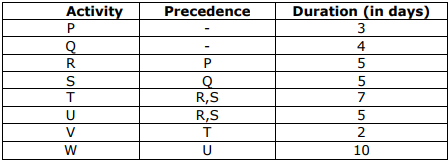Arithmetic - Online Test
Q1. Consider the following PERT network:



The optimistic time, most likely time and pessimistic time of all the activities are given in the table
below.

The critical path duration of the network (in days) is
Answer : Option D
Explaination / Solution:
No Explaination.
Q2. Consider the following PERT network:



The optimistic time, most likely time and pessimistic time of all the activities are given in the table below.

The standard deviation of the critical path is
Answer : Option B
Explaination / Solution:
No Explaination.
Q3. A phenomenon is modeled using n dimensional variables with k primary
dimensions. The number of non-dimensional variables is
Answer : Option C
Explaination / Solution:
No Explaination.
Q4. Simplex method of solving linear programming problem uses
Answer : Option B
Explaination / Solution:
No Explaination.
Q5. The project activities, precedence relationships and durations are described in the
table. The critical path of the project is 

Answer : Option D
Explaination / Solution:
No Explaination.
Q6. Four jobs are to be processed on a machine as per data listed in the table.


If the Earliest Due Date (EDD) rule is used to sequence the jobs, the number of
jobs delayed is
Answer : Option C
Explaination / Solution:
No Explaination.
Q7. Four jobs are to be processed on a machine as per data listed in the table.


Using the Shortest Processing Time (SPT) rule, total tardiness is
Answer : Option B
Explaination / Solution:
No Explaination.
Q8. Hari (H), Gita (G), Irfan (I) and Saira (S) are siblings (i.e. brothers and sisters).
All were born on 1st January. The age difference between any two successive
siblings (that is born one after another) is less than 3 years. Given the following
facts:
i. Hari’s age + Gita’s age > Irfan’s age + Saira’s age
ii. The age difference between Gita and Saira is 1 year. However, Gita is not the
oldest and Saira is not the youngest.
iii. There are no twins.
In what order were they born (oldest first)?
Answer : Option C
Explaination / Solution:
No Explaination.
Q9. 5 skilled workers can build a wall in 20days; 8 semi-skilled workers can build a
wall in 25 days; 10 unskilled workers can build a wall in 30days. If a team has 2
skilled, 6 semi-skilled and 5 unskilled workers, how long will it take to build the
wall?
Answer : Option B
Explaination / Solution:
No Explaination.
Q10. Given digits 2,2,3,3,4,4,4,4 how many distinct 4 digit numbers greater than 3000
can be formed?
Answer : Option B
Explaination / Solution:
No Explaination.
